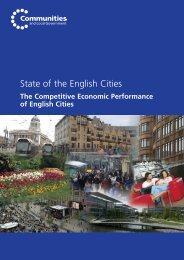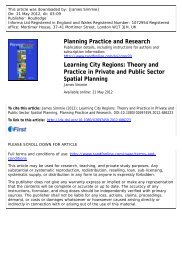History Matters: Path dependence and innovation in British city ...
History Matters: Path dependence and innovation in British city ...
History Matters: Path dependence and innovation in British city ...
You also want an ePaper? Increase the reach of your titles
YUMPU automatically turns print PDFs into web optimized ePapers that Google loves.
Figure 4: Two alternative path <strong>dependence</strong> trajectories<br />
B<br />
Development<br />
of <strong>in</strong>dustrial<br />
sector<br />
A<br />
Shock<br />
<strong>Path</strong> creation<br />
phase<br />
<strong>Path</strong> lock-<strong>in</strong><br />
phase<br />
<strong>Path</strong> renewal<br />
phase<br />
<strong>Path</strong> decay<br />
phase<br />
Time<br />
Trajectory A corresponds to the basic path <strong>dependence</strong> model. Trajectory B refers to a<br />
situation where path decay is avoided <strong>and</strong> the exist<strong>in</strong>g path is renewed <strong>and</strong> extended.<br />
For now, however, the lack of a generally<br />
accepted theory of path <strong>dependence</strong> means<br />
that there are different conceptualisations of<br />
the term <strong>and</strong> also of the possible causes of the<br />
establishment of new pathways. Mart<strong>in</strong> (2003,<br />
p. 29) has identified at least five different<br />
sources of path <strong>dependence</strong>. These are:<br />
1. Dependence on <strong>in</strong>itial external chance<br />
events.<br />
2. Technological lock-<strong>in</strong> (Paul David).<br />
3. Increas<strong>in</strong>g returns (Brian Arthur).<br />
4. Institutional hysteresis (Douglas North,<br />
Mark Setterfield).<br />
5. Social embeddedness.<br />
A critical issue <strong>in</strong> explanations of path<br />
<strong>dependence</strong> is why <strong>and</strong> how new pathways<br />
get started. In much of the path dependency<br />
literature the emergence of novelty <strong>and</strong> new<br />
pathways is said to be accidental. Although<br />
new developments such as the discovery of<br />
penicill<strong>in</strong> or the <strong>in</strong>spiration for Silicon Valley<br />
were partly chance events, reliance on r<strong>and</strong>om<br />
chance is not generally a good enough<br />
explanation for the creation of new pathways.<br />
It offers little explanation, s<strong>in</strong>ce after the <strong>in</strong>itial<br />
chance the rest is merely descriptive history.<br />
Mart<strong>in</strong> <strong>and</strong> Sunley (2006) suggest five possible<br />
reasons for the start of new pathways <strong>in</strong><br />
particular (urban <strong>and</strong> regional) economies.<br />
These are:<br />
1. Indigenous creation.<br />
2. Heterogeneity <strong>and</strong> diversity.<br />
3. Diversification <strong>in</strong>to technologically related<br />
<strong>in</strong>dustries.<br />
4. Upgrad<strong>in</strong>g of exist<strong>in</strong>g <strong>in</strong>dustries.<br />
5. Transplantation from elsewhere (Mart<strong>in</strong> <strong>and</strong><br />
Sunley 2006, p. 420).<br />
The first four of these meet the criteria of<br />
evolutionary systems while, strictly speak<strong>in</strong>g,<br />
the transplantation of <strong><strong>in</strong>novation</strong> <strong>and</strong> novelty<br />
from elsewhere does not.<br />
Most work, particularly by economic<br />
geographers has focused on the first of these<br />
path creation mechanisms – <strong>in</strong>digenous<br />
creation. Here the organisation of the<br />
production <strong>and</strong> transfer of new knowledge is<br />
the key element <strong>in</strong> the establishment of new<br />
14













